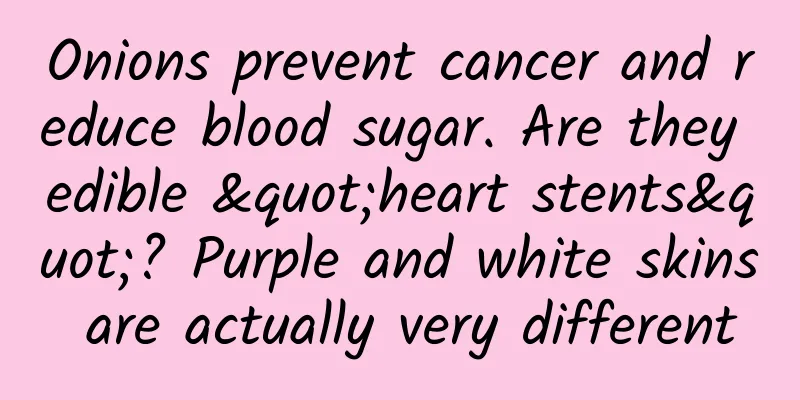Onions prevent cancer and reduce blood sugar. Are they edible "heart stents"? Purple and white skins are actually very different

|
Expert of this article: Zhang Zheng, PhD in Nutrition and Food Hygiene, Soochow University The claim that eating raw onions can protect blood vessels and lower blood pressure has been around for a long time, so much so that some people say that onions are edible "heart stents." Did you know that onions can lower blood sugar levels? Copyright image, no permission to reprint Experts from the World Health Organization found that the reason why Pakistanis are less likely to suffer from diabetes is related to their love of eating onions. The survey found that each Pakistani eats at least two (about 400 grams) onions every day. Onions do not lower blood sugar levels in healthy non-diabetic people, but eating large amounts of onions can lower blood sugar levels in diabetic patients. Are purple onions or white onions more nutritious? Are they best eaten raw or cooked? Let's find out. What are the benefits of eating onions? Onion belongs to the genus Allium of the Liliaceae family, also known as ball onion, round onion, and jade onion. It consists of leaves, stems and roots. The "onion" we usually eat is its scaly stem part - the bulb, which is the onion. Onion heads store most of the nutrients in onions, so they are also very nutritious. In addition to carbohydrates, proteins, water-soluble vitamins, and minerals such as calcium, iron, and selenium, they also contain a variety of nutrients with unique biological activities - sulfur compounds, flavonoids, steroids, polysaccharides, prostaglandins and other phytochemicals. Copyright image, no permission to reprint These nutrients make onions have high nutritional value and health benefits. Onions have antibacterial, antioxidant, blood sugar, blood lipid and cholesterol lowering effects, and they also have a positive effect on cardiovascular disease, diabetes, cancer, osteoporosis, obesity and other diseases. Can onions prevent cancer? Is it an edible “heart stent”? Studies have found that many ingredients in onions have tumor prevention effects. Selenium can cause apoptosis of tumor cells and inhibit the formation of tumor angiogenesis; Quercetin can inhibit tumor cell proliferation and adhesion; Allyl sulfides can block the formation and replication of cancer cell DNA, effectively inhibiting cancers such as gastric cancer, esophageal cancer and colon cancer; Flavonoids can scavenge free radicals and inhibit the growth of tumor cells such as liver cancer and colon cancer. Population studies have also found that increasing the intake of Allium vegetables, including onions, can reduce the risk of cancers such as gastric cancer, colorectal cancer, esophageal cancer, and prostate cancer. Copyright image, no permission to reprint In cardiovascular diseases, onions are also known as "heart stents". Prostaglandin A can dilate blood vessels, reduce blood viscosity, and prevent thrombosis; Amino acids such as S-propylcysteine, S-methylcysteine sulfoxide, and cycloalliin can reduce blood cholesterol levels; The powerful antioxidant ability of flavonoids can remove a large number of free radicals in the blood and reduce the damage of free radicals to blood vessels. The various nutrients contained in onions protect cardiovascular health in various ways. Which groups of people are not recommended to eat onions? The high content of irritating substances in raw onions can irritate the gastric mucosa and cause gastrointestinal discomfort. Therefore, patients with gastritis, gastric ulcers, and duodenal ulcers are not recommended to eat raw onions. Raw onions are very irritating to the stomach, but that doesn't mean eating cooked onions is fine. Regardless of whether they are raw or cooked, eating onions can easily cause gas in the stomach and intestines, causing abdominal distension and pain, so it is not recommended for patients undergoing gastrointestinal surgery to eat onions. In addition, people with allergies and patients with itchy skin diseases are not recommended to eat onions. Which onion is better: purple, yellow or white? Onion varieties can be divided into three categories according to the color of the onion skin: purple, yellow and white. Copyright image, no permission to reprint The main differences between the three are: ● In terms of nutritional content, purple onions are rich in anthocyanins, and the content of allicin and quercetin is also higher; yellow and white onions are rich in carotene and high in vitamin C. ● In terms of taste, purple onions have a thin texture and a spicier taste; white onions have a high water content, a thick texture, and a lighter spiciness; yellow onions are also less spicy and taste sweeter than purple and white onions. ● White and yellow onions with a mild spiciness are suitable for eating raw, while those with a strong spiciness are suitable for use as seasonings in cooking. So when choosing onion varieties, you can choose according to how you eat them and your favorite taste. Here are a few things to keep in mind when buying onions: First, observe the appearance of the onions. If the onion skin is dry and intact without rot, and the onion root is dry without new root sprouts, it means that the onions are well stored. Secondly, be sure to pinch the onion before buying it to feel its texture. The harder it feels, the higher the water content of the onion, and the fresher it is. Everyone must have experienced the experience of bursting into tears while cutting onions. This is because when cutting onions, the onion cells rupture and release alliinase, which reacts with amino acids to form thiopropionaldehyde-S-oxide. Thiopropionaldehyde-S-oxide is volatile and diffuses in the air. When it comes into contact with the eyes, it can stimulate the free nerve endings on the cornea and stimulate the lacrimal glands to shed tears. Copyright image, no permission to reprint So if you want to cut onions without tears, you can try the following methods: 1. Refrigerate the onion before cutting it to lower the temperature of the onion and slow down the volatilization of thiopropionaldehyde-S-oxide. 2. Cut the onion and soak it in water for a while, because propionaldehyde-S-oxide is easily soluble in water, and soaking in water will also reduce the volatilization of propionaldehyde-S-oxide. 3. The easiest way is to wear goggles. The watermarked images and cover images in this article are from the copyright gallery, and the image content is not authorized for reprinting |
<<: Are more expensive razors better? We tested 14 models and found the key to good shaving
Recommend
What is the relationship between cats and tigers?
There is such a story: Once upon a time, a fierce...
A brief analysis of the AARRR model user operation strategy!
There are two purposes for writing this article: ...
How does information flow advertising accurately target users?
With the vigorous development of mobile Internet ...
Why can your activities attract fans but fail to retain them?
The purpose of organizing activities is not to co...
8 tips for through train promotion
Through train promotion skills Many people feel t...
Tik Tok, Kuaishou or Bilibili? How do brands choose short videos?
Recently, Bilibili has become popular because of ...
China Programmer's Guide: Spending more on mortgage loans, looking for a partner with the best appearance
Recently, the author discovered a "2018 Chin...
"Autumn Tiger" takes over "Summer Heat", the situation of consecutive drought in summer and autumn in Jiangnan is not optimistic
Recently, the south has seen a lot of high temper...
Will artificial intelligence make weather forecasts more accurate? my country's new achievement is published in a top international journal
Since ChatGPT came out and artificial intelligenc...
The programmer who can do ten things at once is not a legend
[[129585]] Last night, I posted the following: “S...
How much does it cost to join a lottery app in Fuyang?
How much does it cost to join a lottery app in Fu...
Android phone "runs Stable Diffusion" and sets a new record, producing images within 15 seconds
As we know, Stable Diffusion is a very popular te...
Electronic devices make birds dizzy
Migratory birds travel thousands of miles every ye...
Where does the held urine go?
Audit expert: Zeng Ling Deputy Chief Physician of...
Absorbing moisture from raw meat, frying paper…are you using kitchen paper incorrectly at home?
Image source: Photo Network When you are dealing ...









